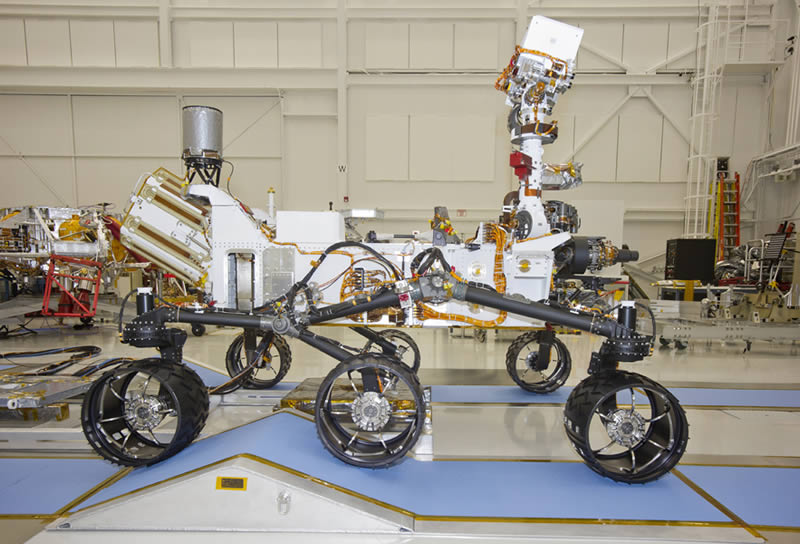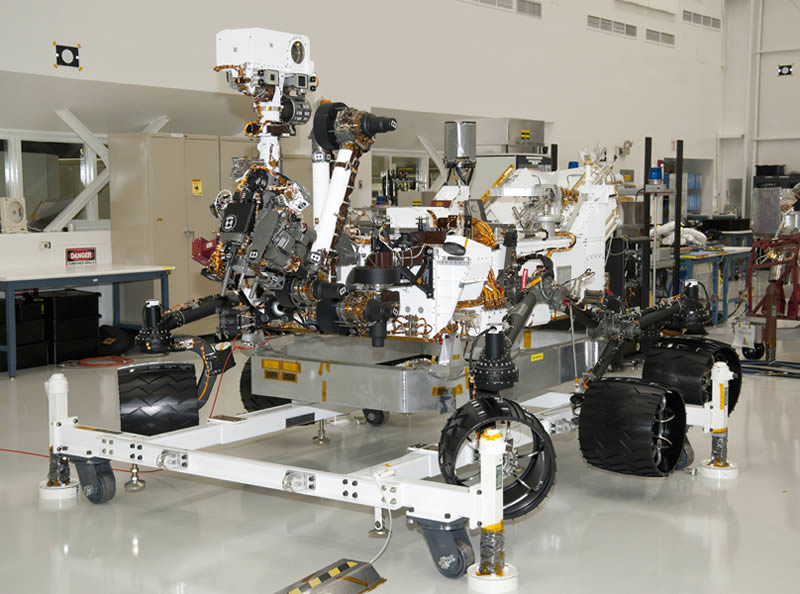Mars Science Laboratory - Curiosity
NASA’s Mars Science Laboratory mission is preparing to set down a large, mobile laboratory — the rover Curiosity — using precision landing technology that makes many of Mars’ most intriguing regions viable destinations for the first time. During the 23 months after landing, Curiosity will analyze dozens of samples drilled from rocks or scooped from the ground as it explores with greater range than any previous Mars rover.
Curiosity will carry the most advanced payload of scientific gear ever used on Mars’ surface, a payload more than 10 times as massive as those of earlier Mars rovers. Its assignment: Investigate whether conditions have been favorable for microbial life and for preserving clues in the rocks about possible past life.
 |
 |
Mission Overview
Plans for the Mars Science Laboratory call for launch from Cape Canaveral Air Force Station, Florida, between Nov. 25 and Dec.18, 2011, and arrival at Mars in August 2012.
The spacecraft has been designed to steer itself during descent through Mars’ atmosphere with a series of S-curve maneuvers similar to those used by astronauts piloting NASA space shuttles. During the three minutes before touchdown, the spacecraft slows its descent with a parachute, then uses retro rockets mounted around the rim of an upper stage. In the final seconds, the upper stage acts as a sky crane, lowering the upright rover on a tether to the surface.
Curiosity is about twice as long (about 3 meters or 10 feet) and five times as heavy as NASA’s twin Mars Exploration Rovers, Spirit and Opportunity, launched in 2003. It inherited many design elements from them, including six-wheel drive, a rocker-bogie suspension system and cameras mounted on a mast to help the mission’s team on Earth select exploration tar-gets and driving routes. Unlike earlier rovers, Curiosity carries equipment to gather samples of rocks and soil, process them and distribute them to onboard test chambers inside analytical instruments.
Science Payload
In April 2004, NASA solicited proposals for specific instruments and investigations to be carried by Mars Science Laboratory. The agency selected eight of the proposals later that year and also reached agreements with Russia and Spain for carrying instruments those nations will provide.
A suite of instruments named Sample Analysis at Mars will analyze samples of material collected and delivered by the rover’s arm, plus atmospheric samples. It includes a gas chromatograph, a mass spectrometer, and a tunable laser spectrometer with combined capabilities to identify a wide range of organic (carbon-containing) compounds and determine the ratios of different isotopes of key elements. Isotope ratios are clues to understanding the history of Mars’ atmosphere and water. The principal investigator is Paul Mahaffy of NASA’s Goddard Space Flight Center, Greenbelt, Md.
An X-ray diffraction and fluorescence instrument called CheMin will also examine samples gathered by the robotic arm. It is designed to identify and quantify the minerals in rocks and soils, and to measure bulk composition. The principal investigator is David Blake of NASA’s Ames Research Center, Moffett Field, Calif.
Mounted on the arm, the Mars Hand Lens Imager will take extreme close-up pictures of rocks, soil and, if present, ice, revealing details smaller than the width of a human hair. It will also be able to focus on hard-to-reach objects more than an arm’s length away. The principal investigator is Kenneth Edgett of Malin Space Science Systems, San Diego.
Also on the arm, the Alpha Particle X-ray Spectrometer for Mars Science Laboratory will determine the relative abundances of different elements in rocks and soils. Dr. Ralf Gellert of the University of Guelph, Ontario, Canada, is principal investigator for this instrument, which will be provided by the Canadian Space Agency.
The Mars Science Laboratory Mast Camera, mounted at about human-eye height, will image the rover’s surroundings in high-resolution stereo and color, with the capability to take and store high-definition video sequences. It will also be used for viewing materials collected or treated by the arm. The principal investigator is Michael Malin of Malin Space Science Systems.
An instrument named ChemCam will use laser pulses to vaporize thin layers of material from Martian rocks or soil targets up to 7 meters (23 feet) away. It will include both a spectrometer to identify the types of atoms excited by the beam, and a telescope to capture detailed images of the area illuminated by the beam. The laser and telescope sit on the rover’s mast and share with the Mast Camera the role of informing researchers’ choices about which objects in the area make the best targets for approaching to examine with other instruments. Roger Wiens of Los Alamos National Laboratory, Los Alamos, N.M., is the principal investigator.
The rover’s Radiation Assessment Detector will characterize the radiation environment at the surface of Mars. This information is necessary for planning human exploration of Mars and is relevant to assessing the planet’s ability to harbor life. The principal investigator is Donald Hassler of Southwest Research Institute, Boulder, Colo.
In the two minutes before landing, the Mars Descent Imager will capture color, high-definition video of the landing region to provide geological context for the investigations on the ground and to aid precise determination of the landing site. Michael Malin is principal investigator.
Spain’s Ministry of Education and Science is providing the Rover Environmental Monitoring Station to measure atmospheric pressure, temperature, humidity, winds, plus ultraviolet radiation levels. The principal investigator is Javier Gómez-Elvira of the Center for Astrobiology, Madrid, an international partner of the NASA Astrobiology Institute.
Russia’s Federal Space Agency is providing the Dynamic Albedo of Neutrons instrument to measure subsurface hydrogen up to one meter (three feet) be-low the surface. Detections of hydrogen may indicate the presence of water in the form of ice or bound in minerals. Igor Mitrofanov of the Space Research Institute, Moscow, is the principal investigator.
In addition to the science payload, equipment of the rover’s engineering infra-structure will contribute to scientific observations. Like the Mars Exploration Rovers, Curiosity will have a stereo navigation camera on its mast and low-slung, stereo hazard-avoidance cameras. Equipment called the Sample Acquisition/Sample Preparation and Handling System includes tools to remove dust from rock surfaces, scoop up soil, drill into rocks and collect powdered samples from rocks’ interiors, sort samples by particle size with sieves, and deliver samples to laboratory instruments.
The Mars Science Laboratory Entry, Descent and Landing Instrument Suite is a set of engineering sensors designed to measure atmospheric conditions and performance of the spacecraft during the arrival-day plunge through the atmosphere, to aid in design of future missions.
Program/Project Management
The Mars Science Laboratory is managed for NASA’s Science Mission Directorate, Washington, D.C., by JPL, a division of the California Institute of Technology in Pasadena. At NASA Headquarters, David Lavery is the Mars Science Laboratory program executive and Michael Meyer is program scientist. In Pasadena, Peter Theisinger of JPL is project manager and John Grotzinger of Caltech is project scientist.
(credits: JPL - NASA - All rights reserved)
